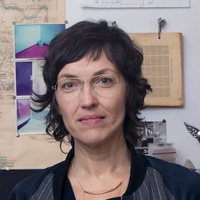On embracing instinct
Prelude
Film colorist Andrea Chlebak has built a reputation for crafting striking looks. Her portfolio includes collaborations with filmmakers like Tim Miller, Neill Blomkamp, Morgan Neville, Panos Cosmatos, Gregory Middleton (ASC), and documentary industries. Now with Harbor Picture Company, she has worked with many leading post-production houses including Deluxe, EFILM, Encore, and Company3. Her recent projects include Lionsgate’s Borderlands, Neon’s Immaculate, Paramount+’s June, Netflix’s Happiness for Beginners, Hulu’s The Girl from Plainville, Apple TV+’s Schmigadoon!, HBOMax’s An American Pickle, Apple’s They Call Me Magic, and Netflix’s Naomi Osaka. Her unique style and ability to create bespoke looks for every film has made a mark on the industry through films such as Neill Blomkamp’s Elysium and award-winning indies like Mandy and Prospect. In addition to her film and advertising credits, Andrea also crafted the look for the latest cinematic video game for Ubisoft, Far Cry 6. In the advertising industry, she has worked on campaigns with major brands including Dodge RAM, American Apparel, Telus, Mercedes Benz, and CVS.
Conversation
On embracing instinct
Film colorist Andrea Chlebak discusses finding her artform, learning that instinct is a powerful tool, the importance of play, and creating a safe place for collaboration.
As told to Kailey and Sam Spear, 2818 words.
Tags: Film, Music, Collaboration, Process, Production, Success.
What was the first time you remember being affected by color in a film?
It’s overwhelming sometimes when I think about it because I am sure there were hundreds of instances where that was happening subconsciously. I think as a kid, we first start watching a lot of films that are animated and kid-driven content. So, I can actually look back to, hilariously, The Lion King as one of my first moments. I can’t remember when that film came out, but I think I was preteen, 9, 10, 11, somewhere in there, to date myself [laughs]. I remember that was the film where I saw something that I felt connected to, in terms of a visual art. I think as a kid it was the first one where I felt like this music and tone and emotion and narrative all kind of came together. It felt so powerful to me.
I remember being in school being like, “I want to be an animator for Disney. I want to go and color and create images like that movie.”
I’d also say that Amélie was a film for me, that was late high school years, that started me on that path towards photographic color approaches and how to process imagery in a way to give emotion to it.

Film still from Mandy (2018)
When did you know that you wanted to be a colorist?
When I went to film school at Emily Carr [University of Art & Design in Vancouver, Canada], I did a lot of on-set directorial work and I learned how to edit. I learned all those things, but I think I was subconsciously color grading images, not really thinking about that as being a role. At the time, I felt like that was part of editing.
Shame on me now for saying that, but I didn’t really know it was even an option until I was probably about two years post college. I was trying to get a job in visual effects because I had felt a calling towards lighting and had been learning about visual effects going into that role. I really loved technology and I had a really good penchant for that. But I also really liked those [post production] teams and that style of artistry, to be a layer to something much bigger.
I was trying to get internships with visual effects companies and there was one post visual effects producer that had pointed out something in my reel and said, “Have you ever thought about being a colorist? Because your stuff is very polished even though I can tell you’re 22 and you don’t have any training in actual public film pieces, but I can see in everything this real attention to color and look.” And that sort of set me off on the path of, “What does that even mean?!” [laughs] I didn’t understand how a colorist could be a creative role.
I ended up working in a couple of different post-production houses. And then I got a role at a company that did film transfer. They expanded and opened a color grading section.
I remember when that stuff started coming through, I was like, “That’s what I want to do. I want to sit in that chair!” And one of the general managers at that facility was like, “100 percent that’s what you should do. Just knowing you, your personality, and what I know you have a good eye for.”
I was kind of in that “right place, right time” kind of situation. It wasn’t something I was seeking, but it sort of landed in front of me and it just felt correct for me at the time.
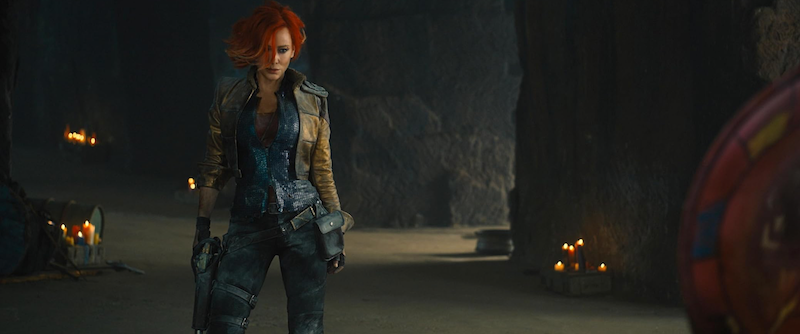
Film still from Borderlands (2024)
It sounds like you came into your job as a colorist with instincts for it already there. Where do you think those instincts came from?
I always had that natural sort of taste or feeling towards things when I would be making things, even as a kid. My mom was a visual artist. She was a baker but she also was a painter and she taught me all of that visual art when I was really little. I was the two-year-old at the kitchen table drawing still lifes. When she’s trying to get stuff done, she’s placing objects like, “Okay, paint it.”
I’d always draw something static and then I would always have something moving in the background. Very commonly I would put a curtain in a window that would be moving, or there would be a balloon doing this or that that had an emotion to it.
There’s something there for me that had to do with being able to identify emotion and embody it in a way. When I started to make art, I was like, “Okay, what’s the feeling I have? And what do I want to come out? What do I not want to come out?” I think the source would always be coming from something that was almost undefined in terms of words or… You know what I mean? It’s a feeling.
I think that’s always been my style of communicating. Sometimes I don’t know what the word is exactly, and you’re going to hear me say a lot of things today because I’m finding the word when I’m talking about it. That’s just something I’ve always leaned on and I wasn’t really made aware of until I got to process learning about what a creative process was.
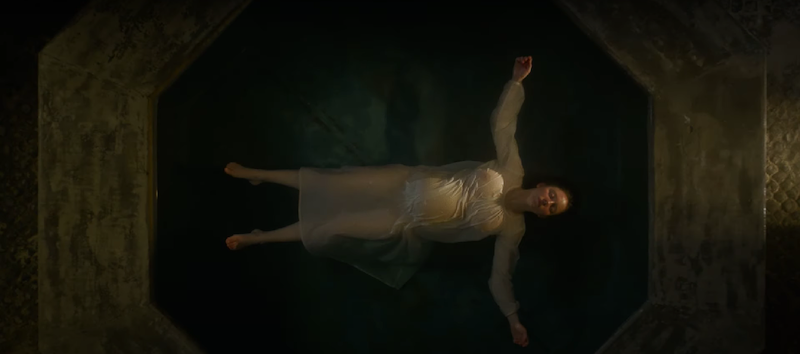
Film still from Immaculate (2024)
You’ve discovered your process is to let your instinct lead the way?
Right. Even after doing two or three years of college and being like, “Okay, that’s what I do,” I still wouldn’t trust [my instinct]. I think it took me five years to properly accept that in myself. Even when becoming a colorist, I tried a lot at the beginning to be really up on technology, really know as much as possible, really put a lot of thought into it.
But when I started to really find what my unique skill was, it was when I was like, “Take a step back, don’t even think about this, just do it.” I would say the last six, seven years, I’ve been really like, “That’s just what I do.” But it’s been a process to even accept that that’s true.

Film still from Borderlands (2024)
What role would you say instinct plays in your decision-making process when coloring a film in comparison to how you prepare for work on a film?
I think I prepare myself so that I can use the instinct, so I can rely on my intuition to get there and contribute in the way I feel is the most valuable.
It could be very overwhelming if you just say, “Oh, just everything’s instinct.” Even for others, because a lot of my role is collaborative, to just sort of say like, “Oh, we’ll figure it out.” That doesn’t work. I’ve learned to balance that with setting up the goalposts of, “This is my workflow of the process I’m going to create.” That’s a bit of a container that provides structure. And within that, there are moments that are undefined that allow for that instinct to shine through. I almost call it the sandbox.
Usually what I do, as part of that process, is I create a little bit of time at the beginning [of a project] where there’s no real structure, except for a time period, like we have two hours or four hours or whatever, and all we’re going to do is play and there’s no result that comes out of that. There are no files, there’s no scene, there’s no real product that we produce. It’s just like, “That’s dedicated time to play.” So, there are no rules.
And if I don’t get that with the collaboration, I will do it for myself. I’d say, “I’m just going to give myself an hour and I’m just going to explore all the possibilities that I feel or I want to play with or try out and see how they make me feel so that I can react to them and then I can bring that to the table.” I’m experimenting with something a little bit more extreme so that when my collaborator, like a cinematographer or director, comes in, they get to have a really strong reaction to it. So it’s almost like I’m forcing them to use their instincts. So, it’s not only me saying, “I want to use my intuition and that’s where I’m the best.” It’s also kind of pushing the other person to lean into [their intuition] as well.
It’s, for me, about creating, being well-prepared with the technical aspects and not having to worry about those, and then creating these little pockets of time throughout the process that are freeform and don’t feel like they’re pressured. I think pressure—time pressure, money pressure, all that stuff—ultimately kills the creative process. How can we feel how we feel if we have worry or anxiety? It’s almost like you can’t feel those things at the same time.

Film stills from Immaculate (2024)
We’d love to hear about your approach in using color as a storytelling tool on the shows and films you work on. Do you have any special techniques or strategies that you use to evoke emotions or mood through color?
I think every project is its own thing. Some films are written in a way that color plays a role in how the story is being told and it’s standing in the foreground. And then, there are other projects where, not that it’s an afterthought, but maybe those words are saying “naturalistic, true reality, honesty”.
I remember a project that I did that was a big sci-fi movie. We had all these flying space objects and droids and robots and things that don’t exist. But then, the sort of contrast of that, is presenting the narrative as it’s real and natural. So those two things are conflicting and they have tension.
Then it becomes like, “I need to now think about color as a story here even more, but it has to be very subtle.” So there’s this kind of tension between how you build the color narrative when you’re not meant to really see it. And then there’s the other ones like a Mandy, which what most people recall from that film is the color of it.

Film still from Mandy (2018)
When it comes in, you’re like, “Okay, it’s going to start looking gritty.” And we’re using all these words like “gritty and contrasty and saturated,” but certain colors that have certain meaning. Then we want those colors to individually exist at different emotional standpoints.
Obviously, we have a color palette we’re trying to work with that might be predefined in art direction and production design. We might enhance it. You can create a moodboard with the color palette and then go, “What of these do we pull out?” Let’s say we use a certain color like you would a theme for a character music. You might have that sort of same approach to color where it’s like, “Well, the blue sort of represents the inner mind of this person. The red sort represents this person’s tension.”
Sometimes we get very into those things, like in Amélie where it’s very specific coded colors you’re playing with as part of the overall narrative.
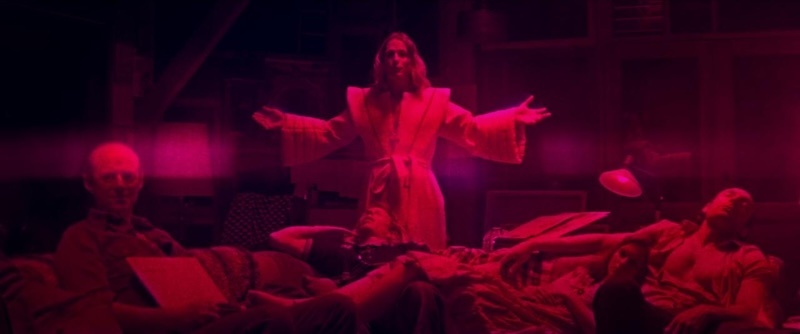
Film still from Mandy (2018)
Then I feel like what I do a lot after that is I start working into the narrative of the color. Whether it’s a thriller, it’s a horror, it’s a comedy, where does it make sense for the color to come forward or come back in terms of the audience experience? I’m often, again, feeling my way through those. I often say, “I work softly alongside.” I try to find ways where and when it makes sense for me to present an idea or to say, “What if we tried it this way? Does that line up with the story?”
Often, as we get through it, everybody gets really excited about these subtle things that have a lot of meaning. I think that’s when it’s really exciting for me. When I’ve been able to play a role in that storytelling and everybody’s like, “Yeah, oh my God, that adds much more to what I thought this was going to be.”
What do you find the most challenging part of working as a colorist?
There are a lot of factors that come into play with how quickly something can be done, how much time can be spent, how many hours and what room and all of those things. And I think we all wish those things would go away, but they do exist. It’s always a challenge for me to just find the balance where the business aspect is sort of pushed to the side and we still get to have that creative and collaborative experience.
You are also a musician. You’re in multiple bands. How do you find collaborating with filmmakers compared to collaborating with musicians?
I think with filmmaking, what I love about it is that you’re not on your own, even though there are moments everybody has where you do feel that way.
I would say the difference though, for me, is that as a colorist you’re sort of making somebody else’s art. You’re taking somebody else’s voice and you’re maybe adding yours or you’re helping them to clarify their voice. But with music, at least what I’m doing, it’s coming from me. It’s given me a lot more insight to my directors or my cinematographers. It’s not as vulnerable for me as a colorist, but I think it is, as a director or a writer. I think when I’ve now had the chance to practice being an artist from that [more vulnerable] place, I have a lot more empathy and understanding of the people that I collaborate with.
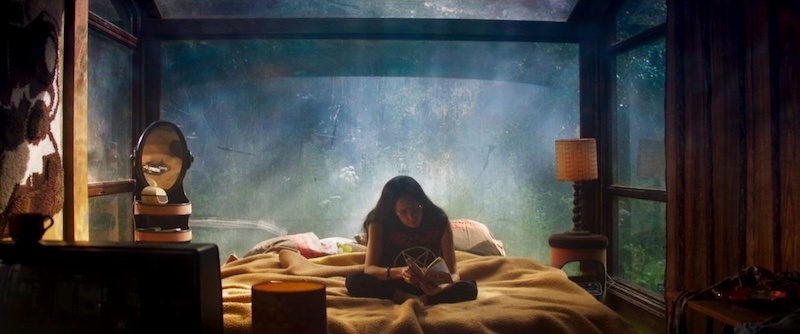
Film still from Mandy (2018)
What do you think is the most important tool in your creative toolkit?
I think now what’s important for me is that sort of ability to be the, I’d almost say, this micro/macro sort of way of seeing. To be able to kind of be in the weeds and understand [details] very clearly but then to be like, “Boom, okay, I’m out here.” The way I do it is, I’m the audience of the work and I try to put myself there so that I can really be like, “This is what we need to do.”
I feel like it’s my ability to make others feel safe to be detailed. And wherever we’re at that they know that it’s still going to be okay. Everything’s going to be okay.
I think, actually, the most important thing is creating a safe space. The ability to create a safe space. Because the real thing, for me, is that sometimes we need to just be talking about that restaurant that we all went to the other day, or that latest Hulu show that everybody’s watching or something about our kids. And you’re working away, you’re getting stuff done, you haven’t stopped, but you’ve been able to connect and create that feeling of safety and trust and comfort. And I think that sometimes can make you extremely productive and creative. I think it takes a certain skill to be able to do that and work at the same time.
Andrea Chlebak recommends:
Caroline Rose, The Art of Forgetting. It’s in my mix and on repeat, I can’t get enough of it
Tony’s Chocolonely chocolate. Dark milk pretzel toffee, this is self explanatory
Color : A Natural History of the Palette. A really good read, true stories behind color and a kind of travelogue from color obsessed, Victoria Finlay
The Beatles, Something music video. I recently rewatched this video as I was taking a deeper dive into modulation in music and songwriting. But the video is so cute, awkward and sweet, it makes me smile.
Bedtime stories. Having a ten year old, I have become really accustomed to reading aloud before bed. We’ve recently tried trading roles, and it made me realize the healing power of having someone, that you love, read you a story in general, but before sleep is especially wonderful.
- Name
- Andrea Chlebak
- Vocation
- film colorist
Some Things
Pagination

